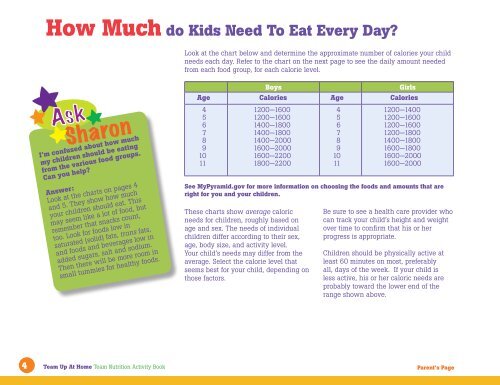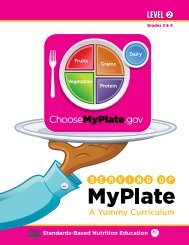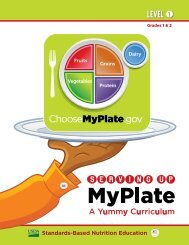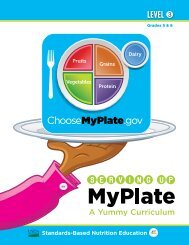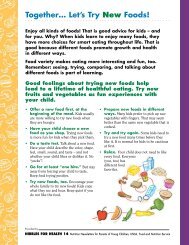Team Up At Home - Team Nutrition - US Department of Agriculture
Team Up At Home - Team Nutrition - US Department of Agriculture
Team Up At Home - Team Nutrition - US Department of Agriculture
Create successful ePaper yourself
Turn your PDF publications into a flip-book with our unique Google optimized e-Paper software.
How Much do Kids Need To Eat Every Day?<br />
Ask<br />
Sharon<br />
I’m confused about how much<br />
my children should be eating<br />
from the various food groups.<br />
Can you help?<br />
Answer:<br />
Look at the charts on pages 4<br />
and 5. They show how much<br />
your children should eat. This<br />
may seem like a lot <strong>of</strong> food, but<br />
remember that snacks count,<br />
too. Look for foods low in<br />
saturated (solid) fats, trans fats,<br />
and foods and beverages low in<br />
added sugars, salt and sodium.<br />
Then there will be more room in<br />
small tummies for healthy foods.<br />
Look at the chart below and determine the approximate number <strong>of</strong> calories your child<br />
needs each day. Refer to the chart on the next page to see the daily amount needed<br />
from each food group, for each calorie level.<br />
Boys Girls<br />
Age Calories Age Calories<br />
4<br />
5<br />
6<br />
7<br />
8<br />
9<br />
10<br />
11<br />
1200—1600<br />
1200—1600<br />
1400—1800<br />
1400—1800<br />
1400—2000<br />
1600—2000<br />
1600—2200<br />
1800—2200<br />
These charts show average caloric<br />
needs for children, roughly based on<br />
age and sex. The needs <strong>of</strong> individual<br />
children differ according to their sex,<br />
age, body size, and activity level.<br />
Your child’s needs may differ from the<br />
average. Select the calorie level that<br />
seems best for your child, depending on<br />
those factors.<br />
4 <strong>Team</strong> <strong>Up</strong> <strong>At</strong> <strong>Home</strong> <strong>Team</strong> <strong>Nutrition</strong> Activity Book Parent’s Page<br />
4<br />
5<br />
6<br />
7<br />
8<br />
9<br />
10<br />
11<br />
1200—1400<br />
1200—1600<br />
1200—1600<br />
1200—1800<br />
1400—1800<br />
1600—1800<br />
1600—2000<br />
1600—2000<br />
See MyPyramid.gov for more information on choosing the foods and amounts that are<br />
right for you and your children.<br />
Be sure to see a health care provider who<br />
can track your child’s height and weight<br />
over time to confirm that his or her<br />
progress is appropriate.<br />
Children should be physically active at<br />
least 60 minutes on most, preferably<br />
all, days <strong>of</strong> the week. If your child is<br />
less active, his or her caloric needs are<br />
probably toward the lower end <strong>of</strong> the<br />
range shown above.


